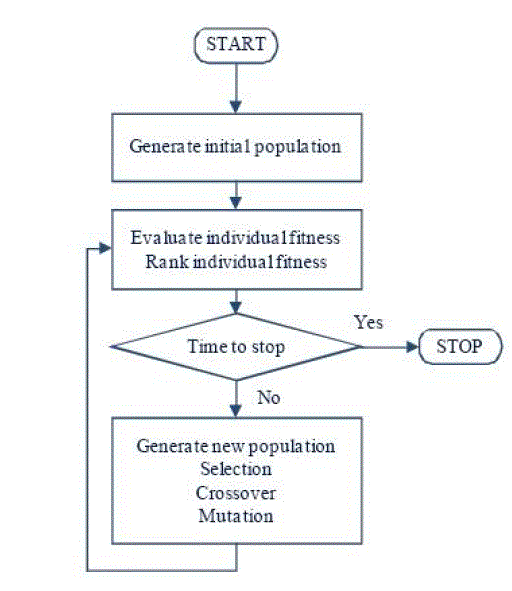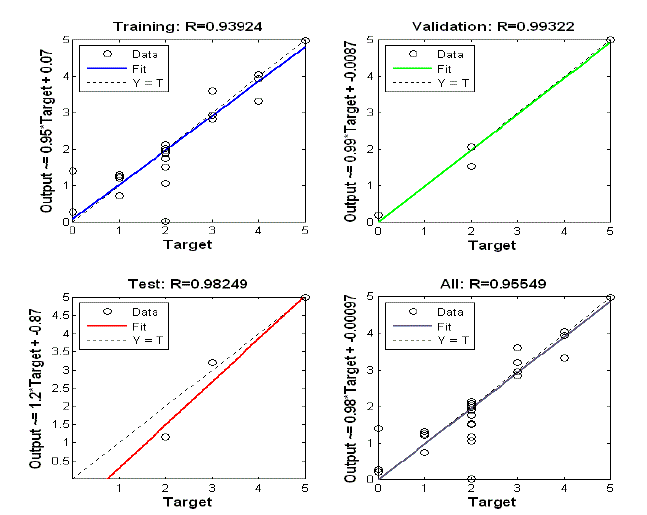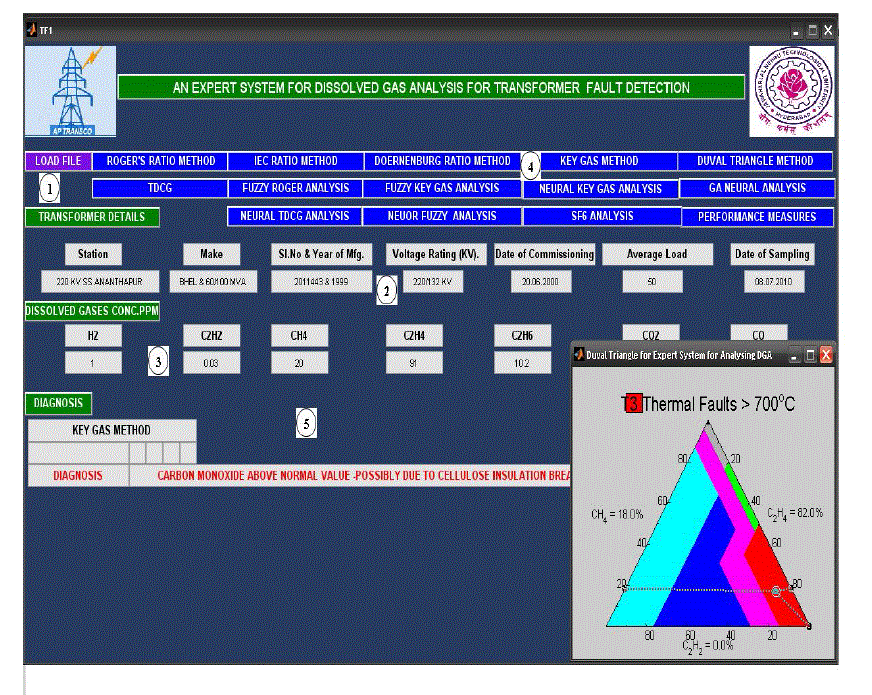Keywords
|
| DGA, GA, ANN |
INTRODUCTION
|
| Dissolved Gas Analysis (DGA) has been used for more than 30 years [1]–[3] for the condition assessment of functioning electrical transformers. DGA measures the concentrations of hydrogen (H2), methane (CH4), ethane (C2H6), ethylene (C2H4), acetylene (C2H2), carbon monoxide (CO) and carbon dioxide (CO2) dissolved in transformer oil. CO and CO2 are generally associated with the decomposition of cellulose insulation; usually, small amounts of H2 and CH4 would be expected as well. C2H6, C2H4, C2H2 and larger amounts of H2 and CH4 are generally associated with the decomposition of oil. All transformers generate some gas during normal operation, but it has become generally accepted that gas generation, above and beyond that observed in normally operating transformers, is due to faults that lead to local overheating or to points of excessive electrical stress that result in discharges or arcing. Despite the fact that DGA has been used for several decades and is a common diagnostic technique for transformers, there are no universally accepted means for interpreting DGA results IEEE C57-104 [3] and IEC 60599 [4] use threshold values for gas levels. |
| Other methods make use of ratios of gas concentrations [2], [5] and are based on observations that relative gas amounts show some correlation with the type, the location and the severity of the fault. Gas ratio methods allow for some level of problem diagnosis whereas threshold methods focus more on discriminating between normal and abnormal behavior. The IEC standard 60599 [18] classifies the DGA detectable transformer faults into 2 categories: the electrical fault and the thermal fault. These two main categories can be further sorted into 6 types of transformer fault, according to the magnitudes of the fault energy: the electrical fault: partial discharge (PD ), D1 (discharge of low energy) and D2 (discharge of high energy); the thermal fault: T1 (Thermal fault of low temperature range, T < 300 ºC), T2 (Thermal fault of medium temperature range, 300 ºC < T < 700 ºC) and T3 (Thermal fault of high temperature range, T >700 ºC) [7].Many DGA analysis techniques employing Artificial Intelligence can be found in the literature. We briefly review here previous techniques for transformer failure prediction from DGA. All of them follow the methodology consisting in feature extraction from DGA, followed by a classification algorithm. The majority of them are techniques [6], [7], [9]–[13], [15], [16] built around a feed-forward neural-network classifier, that is also called Multi-Layer Perceptron (MLP) and that we explain in Section IV. Some of these papers introduce further enhancements to the MLP: in particular, neural networks that are run in parallel to an expert system in [10], Wavelet Networks (i.e. neural nets with a wavelet-based feature extraction) in [16], Self-Organizing Polynomial Networks in [9] and Fuzzy Networks in [6], [12], [13], [15]. Several studies [6], [8], [12], [13], [15], [16] resort to fuzzy logic [18] when modeling the decision functions. Fuzzy logic enables logical reasoning with continuously-valued predicates (between 0 and 1) instead of binary ones, but this inclusion of uncertainty within the decision function is redundant with the probability theory behind Bayesian reasoning and statistics. Stochastic optimization techniques such as genetic programming are also used as an additional tool to select features for the classifier in [8], [12], [14], [16], and [17]. Finally, Shintemirov et al. [17] conduct a comprehensive comparison between k-nearest neighbors, neural networks and support vector machines each of them combined with genetic Programming-based feature selection. |
PROBLEM STATEMENT
|
| The Dissolved Gas Analysis is a diagnostic and maintenance tool used in machinery. Through this method, gases are studied to give an early indication of transformer abnormal behavior. For the last 20 years, this method is widely used for detecting and diagnosing the incipient faults of power transformers. Its effectiveness has been proven by a lot of well known electrical testing laboratories or institutions such as The Institute of Electrical and Electronics Engineers (IEEE), Central Electricity Generating Board of Great Britain (CEGB), International Electro technical Commission (IEC), etc.. Today, numbers of diagnostic methods based on the DGA have been proposed by researchers in the power transmission field from all over the world. |
| The aim of the proposed work is to design a comprehensive tool for dissolved gas analysis that incorporate artificial intelligence elements to aid in incipient transformer fault detection. The objectives of the proposed tool can be listed as to provide seamless integration between different methods of analysis by enabling flexible and easy use of the tool; use hybrid artificial intelligence elements like Neural Network and GA- ANN to improve the diagnostic accuracy of the tool; provide the user with wide variety of options that include traditional methods of analysis like Rogers Ratio, IEC, Duval Triangle etc… to provide a holistic approach in analyzing transformer faults. |
GENETIC ALGORITHM
|
| Genetic algorithm is an adaptive search technique used for solving mathematical problems and engineering optimization problems that emulates Darwin’s evolutionary theory that is fittest is likely to survive. Genetic algorithm attempts to find a good (or best) solution to the problem by genetically breeding a population of individuals over a series of generations. In genetic algorithm, each individual in the population represents a candidate solution to the given problem. The GA transforms a population (set) of individuals, each with an associated fitness value, into a new generation of the population using reproduction, crossover and mutation. Core of the GA is genetic recombination of strings. Generally, a population of strings is randomly generated at the beginning of the process. |
| An important characteristic of GA is that global feature of search is related to the diversity of the initial population: the more diverse the population, the more global the search. From the initial population, selection strategy based on fitness proportion is adopted to select individuals in current population. Higher selective pressure often leads to the loss of diversity in the population, which causes premature convergence but at the same time improves convergence speed. Therefore, a balance is required between population diversity and convergence speed for obtaining the good performance of GA. Then reproduction, cross-over, and mutation operators are randomly applied to produce next generation population until genetic stopping condition is satisfied. GA is much superior to conventional search and optimization techniques in high-dimensional problem space due to their inherent parallelism and directed stochastic search implemented by recombination operators. The block diagram of the Genetic Algorithm is given in the figure below. |
WEIGHT OPTIMIZATION USING GA FOR ANN TRAINING
|
| Artificial neural networks and genetic algorithms are both abstractions of natural processes. They are formulated into a computational model so that the learning power of neural networks and adaptive capabilities of evolutionary processes can be combined [19]. Genetic algorithms can help to determine optimized neural network interconnection weights, as well as, to provide faster mechanism for training of the neural network. Training a given neural network generally means to determine an optimal set of connection weights. This is formulated as the minimization of some network error functions, over the training data set, by iteratively adjusting the weights. The mean square error between the target and actual output averaged over all output nodes serves as a good estimate of the fitness of the network configuration corresponding to the current input. Conventionally a back-propagation neural network (BPNN) updates its weights through a gradient descent technique with backward error propagation. This gradient search technique sometimes gets stuck into local minima. Gas, on the other hand, though not guaranteed to find global optimum solution, have been found to be good at finding “acceptably good” solutions “acceptably quickly” [19]. |
| The GA-based weight optimization during training of an ANN follows two steps. The first step is encoding strings for the representation of connection weights. The second step is the evolutionary process simulated by GA, in which search operators have to be implemented in conjunction with the representation scheme. The evolution stops when the population has converged. A population is said to have converged when 95% of the individuals constituting the population share the same fitness value [20]. The whole process for neural network training using a genetic algorithm is shown below. |
| Step 1: Decoding each individual in the current population into a set of connection weights and construct a corresponding ANN with the weights. |
| Step 2: Evaluating the ANN by computing its total mean square error between actual and target outputs. |
| Step 3: Determining fitness of individual as inverse of error. The higher is the error, the lower is the fitness. |
| Step 4: Storing the weights for mating pool formation. |
| Step 5: Implementing search operators such as cross-over/mutation to parents to generate offspring’s. |
| Step 6: Calculating fitness for new population. |
| Step 7: Repeating steps (3) to (4) until the solution converge. |
| Step 8: Extracting optimized weights. |
ANN BASED SYSTEM FOR TRANSFORMER INCIPIENT FAULT DIAGNOSIS
|
| The basic idea of neural network based diagnosis is non-linear mapping input and outputs. Both back propagation network (BPN) and probabilistic neural network (PNN) are used to diagnose the transformer faults in its incipient stage. An artificial neural network (ANN) includes selection of inputs, outputs, network topology and weighed connection of node. Input features will correctly reflect the characteristics of the problem [18]. Another major work of the ANN design is to choose network topology. This is done experimentally through a repeated process to optimize the number of hidden layers and nodes according to training and prediction accuracy. In this work 7 key gases namely H2, CO, CO2, C2H2, C2H4, C2H6, and CH4 are analyzed to diagnose 5 different fault conditions namely, Corona (CN), Cellulose Insulation Breakdown (CIB), Arcing (ARC), Low Temperature Oil Breakdown (LTOB) and High Temperature Oil Breakdown (HTOB).In this work a Feed – Forward Back Propagation network is used. A TRAINLM training function along with LEANGDM adaptive learning function is used of training and adaptation of the network. MSE is used to compute the performance measure. The total network comprises of 2 layers with layer one having 10 neurons and using a TANSIG transfer function. The regression plot of the regression plot of the network used in the work is given in the Figure (2) |
RESULTS AND CONCLUSION
|
| A comprehensive tool capable of performing different analysis as required by the user is designed. The tool is coded using Matlab Version 7.1 A Graphical User Interface is Designed for to enable the user to have seamless analysis of the data using different methods. Both Traditional Methods and GA – ANN based analysis are available in the tool. |
| The data required for analysis is fed through an Excel sheet in predefined format. This helps in standardizing the input methods and helps in avoiding user induced error. In this work we have used the data format as used by APTRANSCO for collection of Dissolved Gas Analysis data. Once the Data is loaded the basic information about the transformer like its capacity, location, Make, average, load, date of commissioning are displayed in the GUI. Similarly the concentration of different gases in the sample under study is also depicted .Upon clicking the Load button the user is prompted to select a particular Excel work book and a specific sheet for analysis. Once the data is loaded, the user can select the method for analyzing the Data. The functional icons present in the GUI can be described as below in reference to the Figure (3). |
| 1) Functional icon used to load the data for analysis through a Excel spread sheet |
| 2) The Transformer location and other particulars like rating are displayed here. |
| 3) The Concentration of dissolved gases being analyzed is displayed here |
| 4) Functional icons used to execute different methods of analysis |
| 5) Results of the diagnosis are displayed here |
| Whenever the value of the gas being analyzed is in excess of stipulated value as specified by that method of analysis, the diagnosis information is depicted in ‘RED’ otherwise it is depicted in ‘GREEN’. Alert Pop –Ups are also generated to warn about a specific Condition as depicted in Figure (3). |
| The diagnostic accuracy of the proposed method in identifying different faults is given in the tables below. Table 1 indicates the performance in comparison with the training data and table 2 the performance against the test data. |
| The performances of the proposed system and conventional DGA techniques for detecting corona-type PDs are illustrated in Table 3. This confirms the appropriate ability of the proposed systems for detecting PDs of the corona type which occur in the gas phase of voids or gas bubbles and are very different from PDs of the sparking type occurring in the oil phase. |
| The above tables clearly suggest that the proposed method based on GA- ANN is capable of providing much higher accuracy of diagnosis in comparison to the conventional diagnosis methods. |
Tables at a glance
|
|
|
Figures at a glance
|
 |
 |
 |
| Figure 1 |
Figure 2 |
Figure 3 |
|
References
|
- M. Duval and A. dePablo, “Interpretation of gas-in-oil analysis using new IEC publication 60599 and IEC TC 10 databases,” IEEE ElectricalInsulation Magazine, vol. 17, pp. 31–41, 2001.
- M. Duval, “Dissolved gas analysis: It can save your transformer,” IEEE Electrical Insulation Magazine, vol. 5, pp. 22–27, 1989.
- IEEE Guide for the Interpretation of Gases Generated in Oil-Immersed Transformers, IEEE Std. C57.104-2008, 2009.
- Mineral Oil-Impregnated Equipment in Service Guide to the Interpretation of Dissolved and Free Gases Analysis, IEC Std. Publication 60 599, 1999.
- R. R. Rogers, “IEEE and IEC codes to interpret incipient faults in transformers, using gas in oil analysis,” IEEE Transactions on ElectricalInsulation, vol. EI-13, pp. 349–354, 1978.
- J. J. Dukarm, “Tranformer oil diagnosis using fuzzy logic and neural networks,” in CCECE/CCGEI, 1993, pp. 329–332.
- Y. Zhang, X. Ding, Y. Liu, and P. Griffin, “An artificial neural network approach to transformer fault diagnosis,” IEEE Transactions on Power Delivery, vol. 11, pp. 1836–1841, 1996.
- Y.-C. Huang, H.-T. Yang, and C.-L. Huang, “Developing a new transformer fault diagnosis system through evolutionary fuzzy logic,” IEEETransactions on Power Delivery, vol. 12, pp. 761–767, 1997.
- H.-T. Yang and Y.-C. Huang, “Intelligent decision support for diagnosis of incipient transformer faults using self-organizing polynomialnetworks,” IEEE Transactions on Power Delivery, vol. 13, pp. 946–952, 1998.
- Z. Wang, Y. Liu, and P. J. Griffin, “A combined ann and expert system tool for transformer fault diagnosis,” IEEE Transactions on PowerDelivery, vol. 13, pp. 1224–1229, 1998.
- J. Guardado, J. Naredo, P. Moreno, and C. Fuerte, “A comparative study of neural network efficiency in power transformers diagnosis usingdissolved gas analysis,” IEEE Transactions on Power Delivery, vol. 16, pp. 643–647, 2001.
- Y.-C. Huang, “Evolving neural nets for fault diagnosis of power transformers,”IEEE Transactions on Power Delivery, vol. 18, pp. 843–848,2003.
- V. Miranda and A. R. G. Castro, “Improving the IEC table for transformer failure diagnosis with knowledge extraction from neural networks,” IEEE Transactions on Power Delivery, vol. 20, pp. 2509– 2516, 2005.
- X. Hao and S. Cai-Xin, “Artificial immune network classification algorithm for fault diagnosis of power transformer,” IEEE Transactions onPower Delivery, vol. 22, pp. 930–935, 2007
- R. Naresh, V. Sharma, and M. Vashisth, “An integrated neural fuzzy approach for fault diagnosis of transformers,” IEEE Transactions on Power Delivery, vol. 23, pp. 2017–2024, 2008.
- W. Chen, C. Pan, Y. Yun, and Y. Liu, “Wavelet networks in power transformers diagnosis using dissolved gas analysis,” IEEE Transactions on Power Delivery, vol. 24, pp. 187–194, 2009.
- A. Shintemirov, W. Tang, and Q. Wu, “Power transformer fault classification based on dissolved gas analysis by implementing bootstrap and genetic programming,” IEEE Transactions on Systems, Man and Cybernetics, vol. 39, 2009
- Y.-C. Huang, “Evolving neural nets for fault diagnosis of power transformers,” IEEE Trans. Power Del., vol. 18, no. 3, pp. 843–848, July.
- S. N. Pandey, S. Tapaswi, and L. Srivastava, “Integrated evolutionary neural network approach with distributed computing for congestionmanagement,” Applied Soft Computing Journal, vol. 10, no. 1, pp. 251–260, 2010.
- S. Rajasekaran and G. A. V. Pai, Neural Networks, Fuzzy Logic and Genetic Algorithms—Synthesis and Applications, Prentice-Hall Press, New Delhi, India, 2006.
|